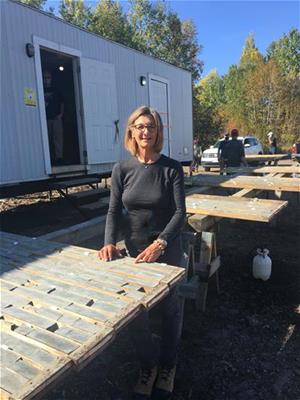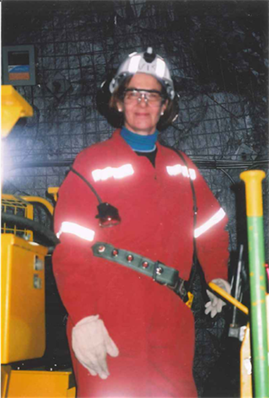How would you describe your job to someone unfamiliar with the title and the sector?
As a chemical engineer with a MBA, the managing consulting group combines technical and commercial insight on a wide range of opportunities in the mining, mineral, metals, infrastructure and energy industries. It involves working with client, internal and other teams, lots of analysis, often travel, coupled with business insights and innovation to recommend feasible solutions. For instance, I work internationally with companies, financers and investors on mergers and acquisitions, strategy, financings, ESG (environment, social and governance), capital project development and operations improvement projects. There is a lot of variety as a management consultant in the mining and mineral sector.
Why did you decide to follow a career in chemical engineering?
 I am not sure there is a short answer to this, as I didn’t have any role models or guidance in high school. It took some time to make the decision to apply to engineering school, as I started university in honours chemistry with a physics minor. But I was encouraged by the boyfriend of a good friend at another university to make the switch. I was very interested in science, math and the environment, and wanted a profession solving practical problems. My parents were incredibly supportive and my father mentioned that with an engineering degree there are so many different opportunities and avenues to follow. So it seemed like a good place to start a career.
I am not sure there is a short answer to this, as I didn’t have any role models or guidance in high school. It took some time to make the decision to apply to engineering school, as I started university in honours chemistry with a physics minor. But I was encouraged by the boyfriend of a good friend at another university to make the switch. I was very interested in science, math and the environment, and wanted a profession solving practical problems. My parents were incredibly supportive and my father mentioned that with an engineering degree there are so many different opportunities and avenues to follow. So it seemed like a good place to start a career.
As the first, and only, female engineer and partner at various organizations throughout your career, did you feel like you had to work harder to prove yourself as a woman in the industry?
Yes, of course I worked hard, but everyone works hard when they are starting out. Universities and companies have been developing programs for diversity and inclusion of women and visible minorities. Of course there is still more work to be done as women still get paid less than men in similar positions, unconscious bias needs to be tackled and there needs to be more women representation on boards and in senior leadership positions. Men have to stand up and support diversity and inclusion at all levels in a company. Many women now make immense contributions, from senior women throughout the ranks.
Is engineering a career that you would recommend to other women, and if so, why?
Yes, it is a great profession. Engineering provides many opportunities, and I think the mining and mineral exploration sector now is being more innovative by using advanced technology and being much more environmentally and socially responsible. It is no longer a sleepy, old sector. There are many new and exciting developments. Engineering is a great way to start a career and I would encourage anybody to consider it. It is a lot of fun, with a lot of variety.
Were there obstacles that you have had to overcome as a woman in your career?
There is still the big issue of systemic bias or unconscious bias. Disturbingly, where I see that manifested the most is when a woman is decisive and provides clear leadership, she could be deemed as bossy or aggressive. A man with those same traits is deemed a strong leader and decisive. It is a tight line to walk and you have to communicate a lot and be very personable. In addition, no matter what sector you are in, women remain underpaid in comparison to men. While we have come a long way, there is still more to go. Fortunately, I see millennial and younger men being very open, unbiased and supportive of women and other minorities.
It is no secret that men dominate the mineral exploration and mining sector. Have you noticed any progress throughout your career to try to close that gap?
 Absolutely. Many companies have made significant strides in the last five years to make things more gender-friendly and inclusive. Small things like equipment modifications and work clothes and safety gear that fits. Many studies show that diverse companies perform better financially, so boards of directors and management in many companies have been through diversity and inclusion training. Diverse teams make better decisions by having a range of options for approaching problem solving. I am not just talking about gender diversity—although that is the first tier—but, diversity of thought improves decision-making. Many companies now appreciate the importance of diversity and have developed programs to hire and retain women to ensure they feel supported in various aspects of their career.
Absolutely. Many companies have made significant strides in the last five years to make things more gender-friendly and inclusive. Small things like equipment modifications and work clothes and safety gear that fits. Many studies show that diverse companies perform better financially, so boards of directors and management in many companies have been through diversity and inclusion training. Diverse teams make better decisions by having a range of options for approaching problem solving. I am not just talking about gender diversity—although that is the first tier—but, diversity of thought improves decision-making. Many companies now appreciate the importance of diversity and have developed programs to hire and retain women to ensure they feel supported in various aspects of their career.
What advice do you have for students, particularly young women, interested in a career within the mining sector?
The minerals and mining sectors offer a wide range of exciting careers. Follow your passion and you will always find a route to do things you want to do. Sometimes it takes a little bit of time. Be confident in your abilities—not just technical skills but also the ability to communicate effectively, work on teams and lead groups. One of the things I tell the women that I mentor—and even the men—is that you have to network. Get to know what options are out there, what other people are doing and where the industry is headed. Get involved in industry associations and volunteer work. Women traditionally have not networked well or feel reticent to reach out to people in the industry for advice. Most people, when you ask them for guidance, will be happy to talk to you and direct you to the others. My youngest daughter is in third-year university and interested in supply chain management. With the pandemic, things look quite challenging. I keep encouraging her to do market research, talk to people in a variety of industries and network to find opportunities something that she likes to do.
Why men are more likely to network than women are?
Well maybe women lack confidence or have not been shown how to do it or have not been encouraged. It is interesting to see how men get onto boards because they went to university together, often meet by playing squash together or at the golf course. It seems to come more naturally for men, the "bro network".